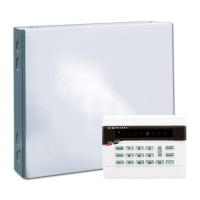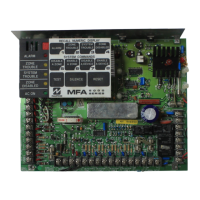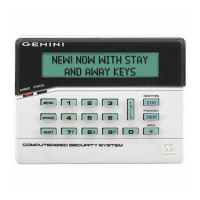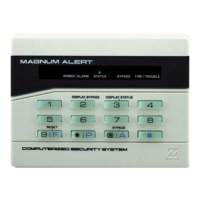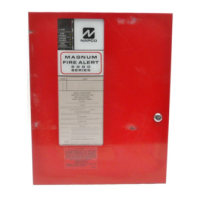Accelaterm
®
Installation and Service Manual 20
RELAY CONNECTIONS
Introduction
The Accelaterm Relay Board provides 17 relays with Nor-
mally-Open, Common, and Normally-Closed contact connec-
tions from each relay. The 16 relays and their connectors that
are associated with Door Lock control are located on the left
and right side of the board. These may be jumper-configured
to be "Dry" or "Wet" outputs. "Dry" contacts normally switch
circuits where the lock circuit is powered from a source away
from the Access Control Panel. "Wet" contacts supply bat-
tery-backed power that can be obtained from within the Ac-
cess Control Panel or from a qualified Power Supply located
in the immediate area of the Access Control Panel.
Fail-safe or Fail-secure
Electric Strikes are available as Fail-safe or Fail-secure de-
vices. Emergency planning may require some areas to use
Fail-safe installations to assure safe passage of personnel after
a prolonged power outage leaves the backup batteries dis-
charged. The disadvantage of a Fail-safe circuit is the con-
tinuous drain on the backup battery during a power outage,
resulting in less backup time. The popular Electromagnetic
(EM) Locks are always Fail-safe.
Fail-safe locks use the Normally-Closed and Common con-
nector pair. When the Access Control Panel logic activates
the relay, the circuit is opened, and passage is allowed. Fail-
secure locks use the Normally-Open and Common connector
pair. When the Access Control Panel logic activates the re-
lay, the circuit is closed, and passage is allowed.
Configuring Unpowered or Powered Contacts
In the same row with the Relay Connector, there is a small
Jumper Block marked D on top and W on bottom. Move both
Jumpers to the top or bottom pair of contacts to select the Dry
or Wet (Powered) output. Relays 1-8 are normally configured
for Doors 1-8 and may receive power through the Charger/
Isolator Board from the 12VDC Power Supply or backup bat-
teries.
The energy budget for the locks associated with first eight
door doors is 4.8A. This is sufficient to maintain eight
600mA Electromagnetic Locks. With this lock load, the in-
ternal batteries can be expected to power the Accelaterm with
eight typical Proximity Readers for 3.5 hours with two
12V/12AH batteries (up to full system load).
Power to Relays 5-8 and 13-16 may be connected to JP4,
LOCK PWR IN (5-8 and 13-16 ) at the bottom-right of the
Relay Board (not evaluated by UL). A Field Wiring Acces-
sory Cable Assembly is available from Continental (part num-
ber 9CICP2800AUXH). Two pairs of conductors supply Re-
lays 5-8 and Relays 13-16. One or two Power-Limited Bat-
tery-Backed 12 or 24VDC Power Supplies carrying UL294 or
UL603 Listings are recommended. The Power Supplies must
be located near the Access Control Panel. Some models carry
connections to meet some considerations for use with a Fire
Alarm Control Panel. (FACP)
Console Relay
Configurable at the Host Computer, the 17
th
relay is the Con-
sole Relay, and activation may be linked to specific events
such as invalid door access, alarm input, and tamper switch
input. A common use is to activate a signal for staff to view
an Alert Screen at a Security Work Station. The Dry-Contact
output is found on the lower-left of the Relay Board.
Auxiliary Relays
Relays not configured to control Door passages may be desig-
nated as Auxiliary Relays and used for low-voltage control
functions.
Relay Characteristics
The relays on the Relay Board all share the following charac-
teristics: Form-C relay with a contact rating of 2A at 28V
AC/DC for connection to Class 2 or power-limited circuits
only. Fast-acting PTC devices limit the relay circuit current
to 2.5A.
Metal oxide varistors (MOV's) are placed across the contacts
to reduce electrical noise. The MOV's limit any noise caused
by the strike coil to 56 volts.
Using door strikes with a coil voltage greater than 28VAC/
VDC requires using external relays that can be driven by the
Accelaterm relays. Likewise, to control currents greater than
2A, external relays must be used.
NOTES: Installing a 56V MOV at the strike coil further re-
duces possible noise input. Additional MOV's are available
from Continental Instruments as part number R783R. Be-
cause of this noise, door strike wiring MUST NOT be put in
the same conduit with other wiring.
Considerations for Fire Safety
The Access Authorizations controlled by the Panel may be
changed to respond to emergency conditions. For example, a
Fire Emergency signaled through an Accessory Alarm Input
can activate a pre-defined emergency response, such as allow-
ing free access through any or all controlled passages.
In a worst-case scenario, when the Access Control Panel is
damaged during the fire emergency several Fail-safe Locks
may be unconditionally opened by an open-circuit from the
FACP (see examples).
RELAY CONNECTIONS

